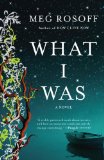Summary | Excerpt | Reading Guide | Reviews | Beyond the Book | Read-Alikes | Genres & Themes | Author Bio

Critics' Opinion:
Readers' Opinion:
First Published:
Jan 2008, 224 pages
Paperback:
Jan 2009, 224 pages
 Book Reviewed by:
Book Reviewed by:
Lucia Silva
Buy This Book
This article relates to What I Was
Useful to Know
If you read
interviews and blogs
about Meg Rosoff you
may find references
to a book called The Dark Ages.
This was the title
that she first gave
to her story about H
and Finn, but which
she later renamed What I Was.
What I Was
was published as
a young adult title
in the UK in summer
2007, but was
positioned as a book
for adults in the USA -
an interesting
situation for an
author who,
according to her
blog, has mixed
feelings about being
identified as a
writer of
"cross-over" novels.
Although the
exact location of St
Oswald's school is
not, as far as we
recollect, mentioned
in the book, from
reading Rosoff's
blog entries we
surmise that it is
close to
Dunwich in
Suffolk. Suffolk is
located in the
southern part of
East Anglia, a
low-lying peninsula
of eastern England (map),
which was one of the
ancient Anglo-Saxon
kingdoms, named for
the Angles of
northern Germany who
settled it around
the 5th century.
Sometime around the
11th century,
Suffolk became a
separate 'shire'*,
but much of the area
consisted of
marshland and bogs
(known as fens)
until the 17th
century when the
rich alluvial land
was converted into
farmland (mainly
arable) by
systematically
draining the area
via drains and river
diversions.
The lost city in the
sea that Finn tells
H about does exist,
although the ravages
of time have left
little to be seen.
According to the
Dunwich website,
the small village
seen today was once
a thriving city,
with an important
boat building
industry and harbor,
home to an
impressive fleet of
royal ships.
However, the city
was built close to
cliffs made of sand
and gravel that were
subject to constant
'soil creep'. On the
14th January 1328
disaster struck. A
hurricane drove the
sea against the spit
of land, shifting
the shingle and
effectively blocking
the entrance to
Dunwich harbor. The
inhabitants worked
hard to clear the
entrance but without
success, and the
ship traffic moved
permanently
elsewhere. By the
end of the 18th
century, over 400
houses, 2 churches,
as well as shops and
windmills, had been
lost to the sea.
By the middle of the
18th century, the
town was effectively
abandoned. By the
time of the 1832
Reform Act, which
abolished "rotten
boroughs" like
Dunwich, there were
just 8 residents
left in the
constituency,
represented in
the British
Parliament by two
MPs!
*Shires were administrative districts created by the Anglo-Saxons, hence the many English counties ending with shire, Hampshire, Nottinghamshire, Wiltshire etc. The shires were governed by shire reeves (a serf elected by the other serfs to supervise the lands for a local lord). Shire reeves became known simply as sheriffs.
![]() This "beyond the book article" relates to What I Was. It originally ran in January 2008 and has been updated for the
January 2009 paperback edition.
Go to magazine.
This "beyond the book article" relates to What I Was. It originally ran in January 2008 and has been updated for the
January 2009 paperback edition.
Go to magazine.





The House on Biscayne Bay
by Chanel Cleeton
As death stalks a gothic mansion in Miami, the lives of two women intertwine as the past and present collide.

The Flower Sisters
by Michelle Collins Anderson
From the new Fannie Flagg of the Ozarks, a richly-woven story of family, forgiveness, and reinvention.

The Funeral Cryer by Wenyan Lu
Debut novelist Wenyan Lu brings us this witty yet profound story about one woman's midlife reawakening in contemporary rural China.
Your guide toexceptional books
BookBrowse seeks out and recommends the best in contemporary fiction and nonfiction—books that not only engage and entertain but also deepen our understanding of ourselves and the world around us.